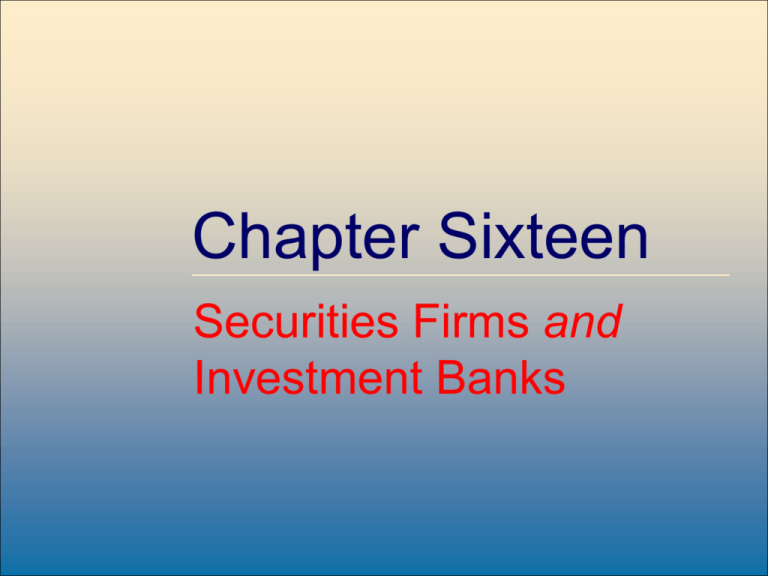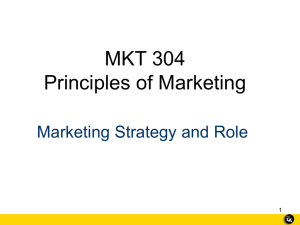
Chapter Sixteen
Securities Firms and
Investment Banks
McGraw-Hill/Irwin
16-1
©2007, The McGraw-Hill Companies, All Rights Reserved
Services Offered by Securities Firms
versus Investment Banks
• Investment Banks
– originating, underwriting, and placing securities in
money and capital markets
• Securities Firms
– brokerage services or market making
• The largest companies in the industry
perform multiple services (e.g., underwriting
and brokerage) and are generally called
investment banks
McGraw-Hill/Irwin
16-2
©2007, The McGraw-Hill Companies, All Rights Reserved
Size, Structure, and Composition of the
Industry
• Three major types of firms
– national full-line investment banks that service
retail and corporate customers (e.g., Merrill Lynch)
– national full-line firms that specialize in corporate
finance (e.g., Goldman Sachs)
– the remainder of the industry
•
•
•
•
•
specialized investment bank subsidiaries of commercial banks
specialized discount brokers ( execute no advice)
regional securities firms
specialized electronic trading securities firms
venture capital firms
McGraw-Hill/Irwin
16-3
©2007, The McGraw-Hill Companies, All Rights Reserved
• Diversified national full line firms that
serve both retail and corporate
customers such as Morgan Stanley.
These firms’ income comes primarily
from brokerage, lending, and
underwriting, although trading activities
are a growing component of income at all
investment banks.
McGraw-Hill/Irwin
16-4
©2007, The McGraw-Hill Companies, All Rights Reserved
• National full line firms specializing in
corporate finance such as Goldman
Sachs. Their income is primarily from
underwriting, placement, mergers and
acquisitions and other consulting
services.
McGraw-Hill/Irwin
16-5
©2007, The McGraw-Hill Companies, All Rights Reserved
• Specialized firms such as
• regional investment bankers (D.A.
Davidson),
• discount brokers (Schwab),
• Internet brokers (E-Trade),
• venture capital firms (New Enterprise) &
• subsidiaries of commercial banks (J.P.
Morgan Chase)
McGraw-Hill/Irwin
16-6
©2007, The McGraw-Hill Companies, All Rights Reserved
Securities Firm and Investment Bank
Activity Areas
• Securities firms and investment banks engage
in as many as seven key activity areas
–
–
–
–
–
–
–
Investing
Investment Banking
Market Making
Trading
Cash Management
Mergers and Acquisitions
Other Service Functions
McGraw-Hill/Irwin
16-7
©2007, The McGraw-Hill Companies, All Rights Reserved
Investing
• Involves managing pools of assets such as mutual
funds.
• Compete with commercial banks, life insurance
companies, and pension funds
• Manage funds either as agents for other investors or as
principals
• Objective is to select asset portfolios to beat some
return-risk performance benchmark such as the S&P
500
• Fee based income from managing investments tends to
be more stable than income from underwriting and
trading which varies more with market cycles.
McGraw-Hill/Irwin
16-8
©2007, The McGraw-Hill Companies, All Rights Reserved
Investment Banking
• Investment banking is underwriting and
distributing new issues of debt and equity. The top 5
underwriters are listed in Text Table 16-2
• The top firms represented about 37% of the total
underwriting volume.
• Morgan Stanley is tops for IPOs and equity, J.P.
Morgan for syndicated loans and
Citigroup/Solomon, Smith-Barney (Citi/SSB) for
straight debt. The old firm of Solomon Brothers
traditionally dominated the debt markets for many
years, and not surprisingly, a strong corporate bank,
J.P. Morgan, dominates in syndicated loans.
McGraw-Hill/Irwin
16-9
©2007, The McGraw-Hill Companies, All Rights Reserved
• A key factor of success in the investment banking
industry is reputation and bankers guard their
firm’s name jealously. Securities underwriting can
be undertaken through either public or private
offerings
– Private placement
– Public placement (Firm commitment, best offer)
• U.S. corporate underwriting activity for debt
issues is almost always many times larger
than the volume of equity underwriting though
equity deals usually dominate the headlines.
McGraw-Hill/Irwin
16-10
©2007, The McGraw-Hill Companies, All Rights Reserved
Market Making
• Market making is creating a secondary
market for securities or contracts.
• These involve both agency (brokerage)
and principle (dealer) functions.( agency
or principal transactions)
• Brokerage is typically paid with
commissions and dealers profit from the
bid-ask spread.
McGraw-Hill/Irwin
16-11
©2007, The McGraw-Hill Companies, All Rights Reserved
• Dealers buy at the bid (low) and sell at
the ask (high).
• Dealers incur the risk of price changes
on the stock since they must maintain an
inventory and bear inventory financing
costs.
• On the NYSE, specialists are designated
market makers that have an affirmative
obligation to ensure ongoing market
liquidity and price continuity.
McGraw-Hill/Irwin
16-12
©2007, The McGraw-Hill Companies, All Rights Reserved
Trading
• Closely related to market-making activities
• Six types of trading
• Position trading: Holing a position for weeks or months
• Pure arbitrage; arbitrage is taking advantage of a
mispricing between two markets by simultaneously
buying and selling the same commodity. Spot futures
arbitrage is a common example.
• Risk arbitrage; taking advantage of a real or perceived
mispricing based on some not happen information; the
trader possesses( insider or so) without perfectly
covering or eliminating all the risk.
McGraw-Hill/Irwin
16-13
©2007, The McGraw-Hill Companies, All Rights Reserved
• Program trading; defined as simultaneous
buying and selling of a portfolio of at least 15
different stocks valued at more than $1 million
in total using a computer program to initiate
the trade. It is like risk arbitrage, find a gap
between spot, cash, future.
• Stock brokerage; processing buy and sell
orders from the public. Many firms either buy
or lease seats on the NYSE and/or are
NASDAQ members. (i.e Merrill Lynch)
McGraw-Hill/Irwin
16-14
©2007, The McGraw-Hill Companies, All Rights Reserved
• Tip: Full service brokers offer research and
advice about which stocks to buy, discount
brokers process public orders for a reduced
fee.
Electronic brokerage offers investors direct
access to the trading floor, bypassing normal
brokers and offering even lower fees than
discount brokers. Examples include E-Trade
and Ameritrade. Most large firms now offer
clients a choice of full service brokerage or
reduced cost electronic trading.
McGraw-Hill/Irwin
16-15
©2007, The McGraw-Hill Companies, All Rights Reserved
Cash Management
• cash management accounts (CMAs)
– money market mutual fund sold by
investment banks that offer check-writing
privileges and FDIC some times
McGraw-Hill/Irwin
16-16
©2007, The McGraw-Hill Companies, All Rights Reserved
Mergers and Acquisitions
• Frequently provide advice on, and
assistance in, mergers and acquisitions
– assist in finding merger partners
– underwrite any new securities
– asses the value of target firms
– recommend terms of the merger agreement
– assist target firms in preventing a merger
McGraw-Hill/Irwin
16-17
©2007, The McGraw-Hill Companies, All Rights Reserved
Michael Jensen,
“Agency Costs of Overvalued Equity,”
• many if not most of the large number of
acquisitions in the late 1990s destroyed
shareholder value. He argues that
overpriced equity led to too low cost of
capital and encouraged managers to
engage in poor investments such as
acquisitions in order to meet analysts’
earnings expectations.
McGraw-Hill/Irwin
16-18
©2007, The McGraw-Hill Companies, All Rights Reserved
• Given that a high P/E ratio predicts rapid
earnings growth; the manager, expected
to hit ever growing earnings targets,
faces an impossible task, because with
overvalued equity management cannot
deliver the expected level of performance
except by chance
McGraw-Hill/Irwin
16-19
©2007, The McGraw-Hill Companies, All Rights Reserved
• Hence firms look for ways to keep the fiction of
improving performance alive, even resorting to
illegal accounting practices and poor
acquisitions. This is a very interesting
argument. It helps explain why there have
been so many scandals lately. It is not that
managers suddenly decided to ‘lie, cheat and
steal.’ The pressure to perform has been very
high, and brought about in part by too close a
tie between Wall Street analysts and corporate
executives, a conflict of interest.
McGraw-Hill/Irwin
16-20
©2007, The McGraw-Hill Companies, All Rights Reserved
• With overvalued equity, stock price signals are
faulty and cannot be relied upon as indicators
of long term value of the firm. Trying to do so
when those signals are wrong must lead to
suboptimal decisions for long term
shareholder wealth. Several firms enlisted
their professional consultants in accounting
and finance to help them find ways to hit
performance targets, which of course could
not continue to occur without some form of
‘cheating’ such as accounting manipulations..
McGraw-Hill/Irwin
16-21
©2007, The McGraw-Hill Companies, All Rights Reserved
• This argument does not excuse
managers. They should have known
better. In particular what we have seen is
a major breakdown of corporate
governance at the board level and a
failure of ethics and a breach of fiduciary
duty and trust among too many
managers who were very highly paid to
look out for shareholders interests
McGraw-Hill/Irwin
16-22
©2007, The McGraw-Hill Companies, All Rights Reserved
Other Service Functions
• Custody and escrow services
• Clearance and settlement services
• Research and advisory services
McGraw-Hill/Irwin
16-23
©2007, The McGraw-Hill Companies, All Rights Reserved
Balance Sheet Assets, 2004
Assets
Cash
$ 50,744.0
Receivable from other broker-dealers
1,530,227.0
Receivable from customers
163,159.2
Receivables from noncustomers
18,345.8
Long positions in securities/commodities 1,075,696.7
Securities and investments not marketed
11,753.1
Securities purchased w/resell agreement
967,008.0
Exchange membership
1,086.6
Other assets
162,346.1
Total assets
$3,980,375.4
McGraw-Hill/Irwin
16-24
1.28%
38.44
4.10
0.46
27.02
0.30
24.29
0.03
4.08
100.00
©2007, The McGraw-Hill Companies, All Rights Reserved
Balance Sheet Liabilities, 2004
Liabilities
Bank loans payable
$ 75,548.8
Payables to other broker-dealers
842,983.0
Payables to noncustomers
66,995.6
Payables to customers
407,432.6
Short positions in securities/commodities 510,513.0
Securities sold w/repurchase agreements 1,565,003.7
Other nonsubordinated liabilities
286,459.8
Subordinated liabilities
75,921.7
Total liabilities
$3,830,858.1
1.90%
21.18
1.68
10.23
12.82
39.32
7.20
1.91
96.24
Capital
Equity capital
Number of firms
McGraw-Hill/Irwin
149,517.3
6,549
16-25
3.76
©2007, The McGraw-Hill Companies, All Rights Reserved
Regulation
• The primary regulator of the securities
industry is the Securities and Exchange
Commission (SEC)
• SEC sets rules governing securities firms’
underwriting and trading activities
• Shelf registration
• The Securities Investor Protection
Corporation (SIPC)
McGraw-Hill/Irwin
16-26
©2007, The McGraw-Hill Companies, All Rights Reserved
Recent Trends
• As goes the stock market, so goes
securities firms’ profitability. Industry
profits are strongly cyclical. Extended
bull markets are good for profits,
employment and growth; crashes and
downturns hurt trading volume and
hence commission income (a mainstay
of revenue at most firms).
McGraw-Hill/Irwin
16-27
©2007, The McGraw-Hill Companies, All Rights Reserved
• Fewer firms seek to issue new equity
during a bear market, and debt issuance
drops off as coverage ratios decline so
underwriting income is also cyclical.
Both underwriting and brokerage income
recovered dramatically in the 1990s after
dropping off precipitously subsequent to
the 1987 crash
McGraw-Hill/Irwin
16-28
©2007, The McGraw-Hill Companies, All Rights Reserved
•
Profitability remained strong with the bull market of
the 1990s. Industry profits were at a record high $21
billion in 2000, but fell 50% in 2001. Reasons for the
profit problems included the weak stock market, the
September 11 2001 attacks, the drop in M&A activity,
and loss of confidence by investors due to the many
ethical violations by some corporations, bankers and
auditors. Profitability remained poor in 2002 at $6.9
billion, but picked up in 2003, hitting a record $22.5
billion and remained high at $19.5 billion in 2004 on
large increases in underwriting activity and hefty cuts
in interest and operating expenses. ROE for 2004 was
13.04%.
McGraw-Hill/Irwin
16-29
©2007, The McGraw-Hill Companies, All Rights Reserved
Global Issues
• Investment banking activities are highly
globalized. For instance, UBS, a Swiss bank, is
the number one underwriter of municipal
securities in the U.S.
• Foreign transactions in U.S. securities and
U.S. transactions in foreign securities have
been growing at a (compound) annual rate of
25.5% and 20.9% respectively.
• International offerings have also grown
rapidly, but recent scandals and the U.S. stock
market weakness has probably deterred
foreign issuers from raising capital in the U.S.
McGraw-Hill/Irwin
16-30
©2007, The McGraw-Hill Companies, All Rights Reserved
Tip
•
Investment bankers can help U.S. institutions gain exposure to
international markets. Banks have created structured derivative
debt products that allow an institution to earn higher overseas
interest rates while limiting exchange rate risk. Bankers can also
sometime help improve the marketability of foreign bonds that are
difficult to sell because they are denominated in a foreign
currency. Many U.S. financial institutions are limited as to how
much currency risk they can incur. Bankers have at times
securitized these foreign currency denominated bonds by placing
them in a trust and issuing dollar denominated claims to U.S.
buyers.] Hedge funds engage in risk arbitrage strategies on a
global basis. The most famous of these (or infamous), Long Term
Capital Management, engaged in risk arbitrage on an
unprecedented global scale .
McGraw-Hill/Irwin
16-31
©2007, The McGraw-Hill Companies, All Rights Reserved





